Cove Heaters
Cove heaters offer an effective means of heating individual rooms—especially
bathrooms. But to many people, they seem like a counterintuitive solution.
We know hot air rises, so why put the heater near the ceiling and expect
it to heat the floor? The answer lies in the nature of radiant heat.
Convection heaters heat air, which rises when warmed, but radiant heaters
heat objects directly, not the space between them. A cove heater transmits
its heat energy directly to the floor, so tile and other hard surfaces
are ideal recipients, acting as a sort of thermal bank to store and release the heat.
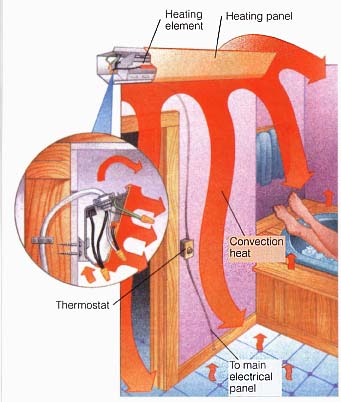 Cove heaters, requiring relatively simple routing of wires in the wall, come in a variety of lengths and can be controlled by a wall-mounted timer or thermostat. Insulated floors are best at holding the heat.
Cove heaters, requiring relatively simple routing of wires in the wall, come in a variety of lengths and can be controlled by a wall-mounted timer or thermostat. Insulated floors are best at holding the heat.
Wall Heaters
Wall heaters can be convection or radiant units and , though most are electric, some models use propane or natural gas. Electric units often require a dedicated electrical circuit, one that has no other load except the heater. Most are intended for heating a single room and will operate on 120-volt current for smaller areas, such as bathrooms, or on 220-volt current. The general guideline for heater capacity is to allow at least 10 watts of heating power for every sq. ft. (110 watts per sq. m) of floor area, unless there’s already a primary heat source in the room. If you don’t find anything that provides that exact ratio, install one with the next larger size or rating.
Installing a wall heater requires cutting open the wall surface between two studs and running wiring to the opening, typically through the top or bottom plate of the wall. Most wall heaters have a built-in thermo stat or timer with adjustment controls right on the front panel, so wiring a separate wall thermostat isn’t necessary. You’ll also have to add horizontal 2x4 blocking above and below the heater housing. The blocking provides a secure mount and also a backing surface for the drywall around the opening’s perimeter. Bathrooms are an ideal application for wall heaters.
Radiant versions heat one or more electric coils and have a reflective
back panel to channel the heat energy into the room. Convection units
have a fan mounted behind the heating coil and actively circulate heated
air. Most units require their own electrical circuit, so plan to run
new wiring and add a circuit breaker to your main electrical panel (a
substantial job). Avoid installing them in exterior wall cavities.
Baseboard and Kick-Space Heaters
Positioning supplemental heat sources low helps keep feet warm, a benchmark for comfort. Baseboard heaters are long, slender units that provide passive convection heat via an electric-wire element or a coil of copper tubing that circulates hot water. Kick-space heaters are fan-forced convection units that fit inside a cabinet toe-kick.
Baseboard: Too slender to accommodate an internal fan,
a baseboard heater relies on passive convection to draw cool air from
just above the floor. The air rises as it flows past the long core of
heating fins and exits through a vent along the top of the heater.
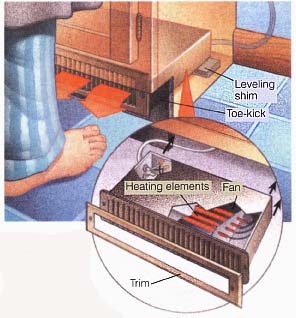 Toe-kick:
If your bathroom has a vanity cabinet with a recessed toe-kick, you can
usually add an electric toe-kick heater. Some feature integral thermostats
but require that you bend or kneel to adjust the controls.
Toe-kick:
If your bathroom has a vanity cabinet with a recessed toe-kick, you can
usually add an electric toe-kick heater. Some feature integral thermostats
but require that you bend or kneel to adjust the controls.

Troubleshooting Electric Heaters
Problem |
Possible Cause |
Solution |
No heat |
Thermostat is set too low. Draperies or furnishings block airflow. Circuit breaker tripped or fuse is blown. Circuit breaker trips again; new fuse melts. Resistance wire in heating element is defective. Wiring connections inside heater are loose. House wiring is defective. |
Adjust thermostat until heat goes on. Remove the obstruction(s). Switch the breaker to on or replace fuse. Check for short-circuit in wiring. Turn off circuit breaker to heater and check wire with continuity tester; replace element with one of same voltage rating. Turn off circuit breaker or pull fuse to heater circuit; check and tighten all connections. Have an electrician check wiring. |
Heater cycles on and off frequently |
Draperies, furniture or debris block airflow. |
Remove the obstruction(s). |
Heater will not shut off |
Heat loss from room is greater than heater’s capacity. |
Close doors and windows. Add weather strip- ping and /or insulation. Supplement with additional heaters. |
Heater emits smoke or odors |
Thermostat is defective. Dust, dirt or lint have accumulated inside. |
Rotate thermostat knob to lowest setting; if heater continues to run, replace thermostat. Vacuum heater using an extension tool. |
Fan doesn’t operate on fan-equipped heater |
Blades are jammed. Wires aren't connected to fan motor. Fan motor is defective. |
Turn off power to heater; remove cover and inspect. Remove any obstruction(s). Turn off power to heater; connect fan wires. Use volt-ohm meter to see whether current is reaching motor. If so, replace motor; if not, check wiring, switch and circuit breaker. |
Fan rotates but no heat is produced |
Resistance wiring in heating element is defective, Wiring connections inside heater are loose, |
Turn off circuit breaker to heater or check wire with a continuity tester. Replace element with one of the same voltage rating. Turn off circuit breaker to heater; check and tighten all wire connections. |
Types of Electric Heaters
Permanent electric convection heaters come in three types; recessed wall-mount or floor-mount units, kick-space units, and baseboard units.
Recessed heaters nest between wall studs or floor joists and feature a fan and either a built-in or in-line thermostat.
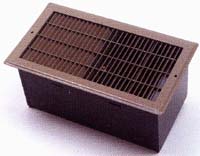
Toe-kick space heaters are designed to fit in the space under a kitchen base cabinet or a bath vanity cabinet. These units provide fan-forced heat.

Baseboard heaters rely on natural convection, drawing cool air in through the lower slot. The heated air flows out the top slot.
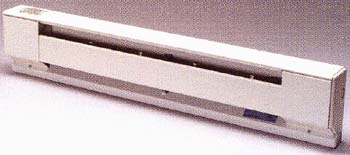
Sizing an Electric Heater
Electric heaters for single rooms are rated according to their energy consumption, with ratings typically ranging from 750 to 5,000 watts.
The first step in selecting the right size of heater is to determine the floor area; simply multiply the room’s length by its width. To determine heater size for a room with normal ceiling height, figure on about 10 watts per sq. ft. (110 watts per sq. m).
Factors, such as climate, location of room, number of exterior wails, and amount of insulation can greatly effect these numbers.
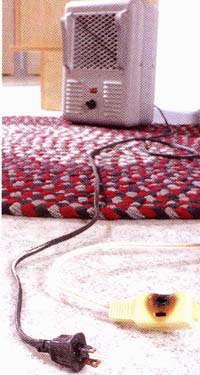
Prevent Fires
Although they are usually of lower wattage than built-in units, portable heaters are responsible for more residential fires. Under size or dam aged extension cords can result in over heated wires and arcing current. For safety, always plug the heater directly into a wall outlet. Always keep heaters away from flammable materials or objects.

